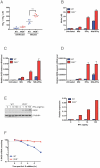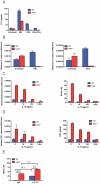Improved control of tuberculosis and activation of macrophages in mice lacking protein kinase R
- PMID: 22359543
- PMCID: PMC3281035
- DOI: 10.1371/journal.pone.0030512
Improved control of tuberculosis and activation of macrophages in mice lacking protein kinase R
Erratum in
-
Correction: Improved Control of Tuberculosis and Activation of Macrophages in Mice Lacking Protein Kinase R.PLoS One. 2018 Oct 5;13(10):e0205424. doi: 10.1371/journal.pone.0205424. eCollection 2018. PLoS One. 2018. PMID: 30289942 Free PMC article.
Abstract
Host factors that microbial pathogens exploit for their propagation are potential targets for therapeuic countermeasures. No host enzyme has been identified whose genetic absence benefits the intact mammalian host in vivo during infection with Mycobacterium tuberculosis (Mtb), the leading cause of death from bacterial infection. Here, we report that the dsRNA-dependent protein kinase (PKR) is such an enzyme. PKR-deficient mice contained fewer viable Mtb and showed less pulmonary pathology than wild type mice. We identified two potential mechanisms for the protective effect of PKR deficiency: increased apoptosis of macrophages in response to Mtb and enhanced activation of macrophages in response to IFN-gamma. The restraining effect of PKR on macrophage activation was explained by its mediation of a previously unrecognized ability of IFN-gamma to induce low levels of the macrophage deactivating factor interleukin 10 (IL10). These observations suggest that PKR inhibitors may prove useful as an adjunctive treatment for tuberculosis.
Conflict of interest statement
Figures







Similar articles
-
Evidence for dispensability of protein kinase R in host control of tuberculosis.Eur J Immunol. 2018 Apr;48(4):612-620. doi: 10.1002/eji.201747180. Epub 2018 Feb 28. Eur J Immunol. 2018. PMID: 29436711 Free PMC article.
-
Potential role of PKR in double-stranded RNA-induced macrophage activation.EMBO J. 2000 Jul 17;19(14):3630-8. doi: 10.1093/emboj/19.14.3630. EMBO J. 2000. PMID: 10899117 Free PMC article.
-
Novel role for calcium-independent phospholipase A(2) in the macrophage antiviral response of inducible nitric-oxide synthase expression.J Biol Chem. 2002 Oct 11;277(41):38449-55. doi: 10.1074/jbc.M206247200. Epub 2002 Aug 6. J Biol Chem. 2002. PMID: 12167650
-
Double-stranded RNA-dependent protein kinase is not required for double-stranded RNA-induced nitric oxide synthase expression or nuclear factor-kappaB activation by islets.Diabetes. 2001 Feb;50(2):283-90. doi: 10.2337/diabetes.50.2.283. Diabetes. 2001. PMID: 11272138
-
Induction of apoptosis by the dsRNA-dependent protein kinase (PKR): mechanism of action.Apoptosis. 2000 Apr;5(2):107-14. doi: 10.1023/a:1009664109241. Apoptosis. 2000. PMID: 11232238 Review.
Cited by
-
Leishmania Infection Engages Non-Receptor Protein Kinases Differentially to Persist in Infected Hosts.Front Immunol. 2016 Apr 18;7:146. doi: 10.3389/fimmu.2016.00146. eCollection 2016. Front Immunol. 2016. PMID: 27148265 Free PMC article. Review.
-
Increased severity of tuberculosis in Guinea pigs with type 2 diabetes: a model of diabetes-tuberculosis comorbidity.Am J Pathol. 2014 Apr;184(4):1104-1118. doi: 10.1016/j.ajpath.2013.12.015. Epub 2014 Jan 31. Am J Pathol. 2014. PMID: 24492198 Free PMC article.
-
A journey in science: promise, purpose, privilege.Mol Med. 2013 Oct 3;19(1):305-13. doi: 10.2119/molmed.2013.00063. Mol Med. 2013. PMID: 24089245 Free PMC article.
-
Fresh approaches to anti-infective therapies.Sci Transl Med. 2012 Jun 27;4(140):140sr2. doi: 10.1126/scitranslmed.3003081. Sci Transl Med. 2012. PMID: 22745440 Free PMC article. Review.
-
Interaction of Mycobacterium tuberculosis with host cell death pathways.Cold Spring Harb Perspect Med. 2014 Jun 26;4(8):a022459. doi: 10.1101/cshperspect.a022459. Cold Spring Harb Perspect Med. 2014. PMID: 24968864 Free PMC article. Review.
References
-
- Schwegmann A, Brombacher F. Host-directed drug targeting of factors hijacked by pathogens. Sci Signal. 2008;1:re8. - PubMed
-
- Cohen SN. Microbial drug resistance: An old problem in need of new solutions. In: Relman DA, Hamburg MA, Choffnes EE, Mack A, editors. Microbial Evolution and Co-Adaptation:A Tribute to the Life and Scientific Legacies of Joshua Lederberg. National Academies Press; 2009. pp. 173–180. 2009; Washington, DC. - PubMed
-
- Philips JA, Rubin EJ, Perrimon N. Drosophila RNAi screen reveals CD36 family member required for mycobacterial infection. Science. 2005;309:1251–1253. - PubMed
-
- Kuijl C, Savage ND, Marsman M, Tuin AW, Janssen L, et al. Intracellular bacterial growth is controlled by a kinase network around PKB/AKT1. Nature. 2007;450:725–730. - PubMed
Publication types
MeSH terms
Substances
LinkOut - more resources
Full Text Sources
Medical

